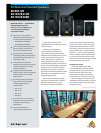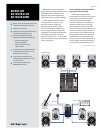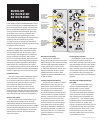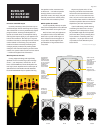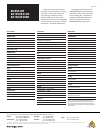
Page 4 of 5
Processor controlled output
Dynamic processing is one of the best ways to
maximize output without sacri cing sound quality.
The D Series’ built-in circuitry automatically adjusts
program content, allowing the loudspeaker to
operate at extreme levels. It accomplishes this by
reducing bass output slightly as you approach the
limit of the transducers. This frees up LF amp and
transducer resources, so that higher overall volume
can be realized. It’s like having a tiny soundman
inside each cabinet constantly monitoring and
changing output parameters. By making subtle
changes to the crossover frequency and the audio
content, the system is able to crank out more sound
— without the slightest hint of distortion.
Massive power to size ratio
Cutting-edge technology and high- delity
speakers are not all it takes to get your message
across — you need power, and lots of it. At the
heart of each EUROLIVE D Series loudspeaker are
two high-current ampli ers with a total output of
550-Watts for the B212D/B215D and 200-Watts
for the B210D/B208D. They’re capable of driving
the speakers to their maximum with
no distortion — and without speaker
damage, thanks to active internal
protection circuits. Put simply, they will
astound you with their massive punch,
smooth mids and articulate top-end!
Which speaker do I need?
As you’ve probably noticed, we make
these active loudspeakers in four di erent
woofer sizes. Which one is right for you?
Well, let’s start with your application.
Is it spoken word in a hotel ballroom?
Hard rock in a park? A folk singer or a
drum ‘n’ bass DJ? Loud enough for an
18-year old or loud enough for your
grandmother? A huge auditorium or
a tiny club?
Physics are physics and a 15" low
frequency transducer has almost 40%
more surface area with which to move
air than a 12". A 12" has 30% more area
than a 10", and a 10" has 35% more than
an 8". So the easiest answer is “Whether to
choose one speaker cabinet over another
depends on your bass requirements.”
If you’re addressing a small meeting,
or demoing the latest “slice-o-chop-o-
vegamatic” at the swap meet or county
fair, the B208D might be all the speaker
you’ll need. But if you’re providing disco
to the masses at a standing room only
nightclub — or you just need to crank
it up louder, then the B215D may be a
better choice.
B215D B212D B210D B208D
Impact
resistant,
molded
enclosure.
Trapezoid shape
allows use as
a powered
monitor wedge
Ultra-wide
dispersion and
large format horn
State-of-the-art
1.35" aluminum-
diaphragm
compression driver
for exceptional
high-frequency
reproduction
Extremely
powerful
15"/12"/10"/8"
long-excursion
LF transducer
provides incredibly
deep bass and
acoustic power
Ergonomically
shaped carry
handles on each
side of enclosure
for easy transport
of system. Two
handles on
B212D/B215D,
one on B210D
1⁄" (35-mm) pole
socket for standard
speaker stands
Rubber feet
for stacking
enclosure on
structures or
subwoofers
Continued on next page
EUROLIVE
B215D/B212D
B210D/B208D



